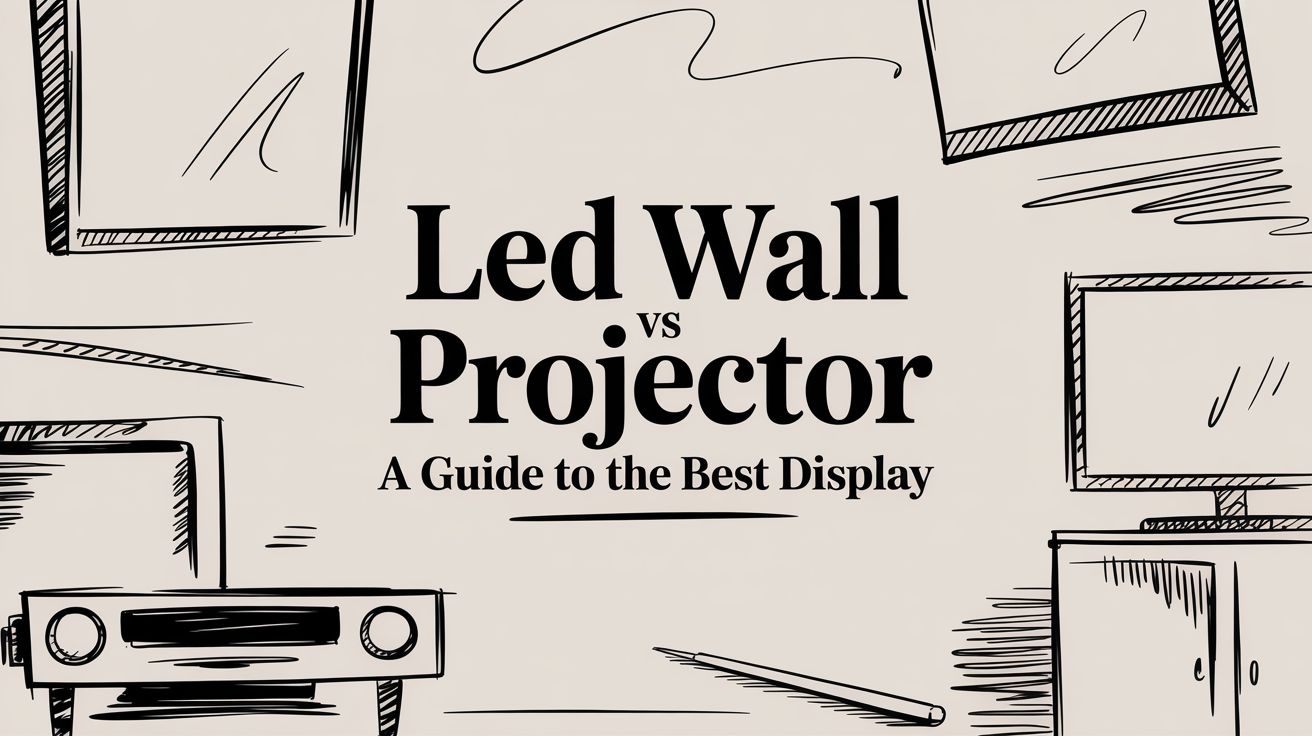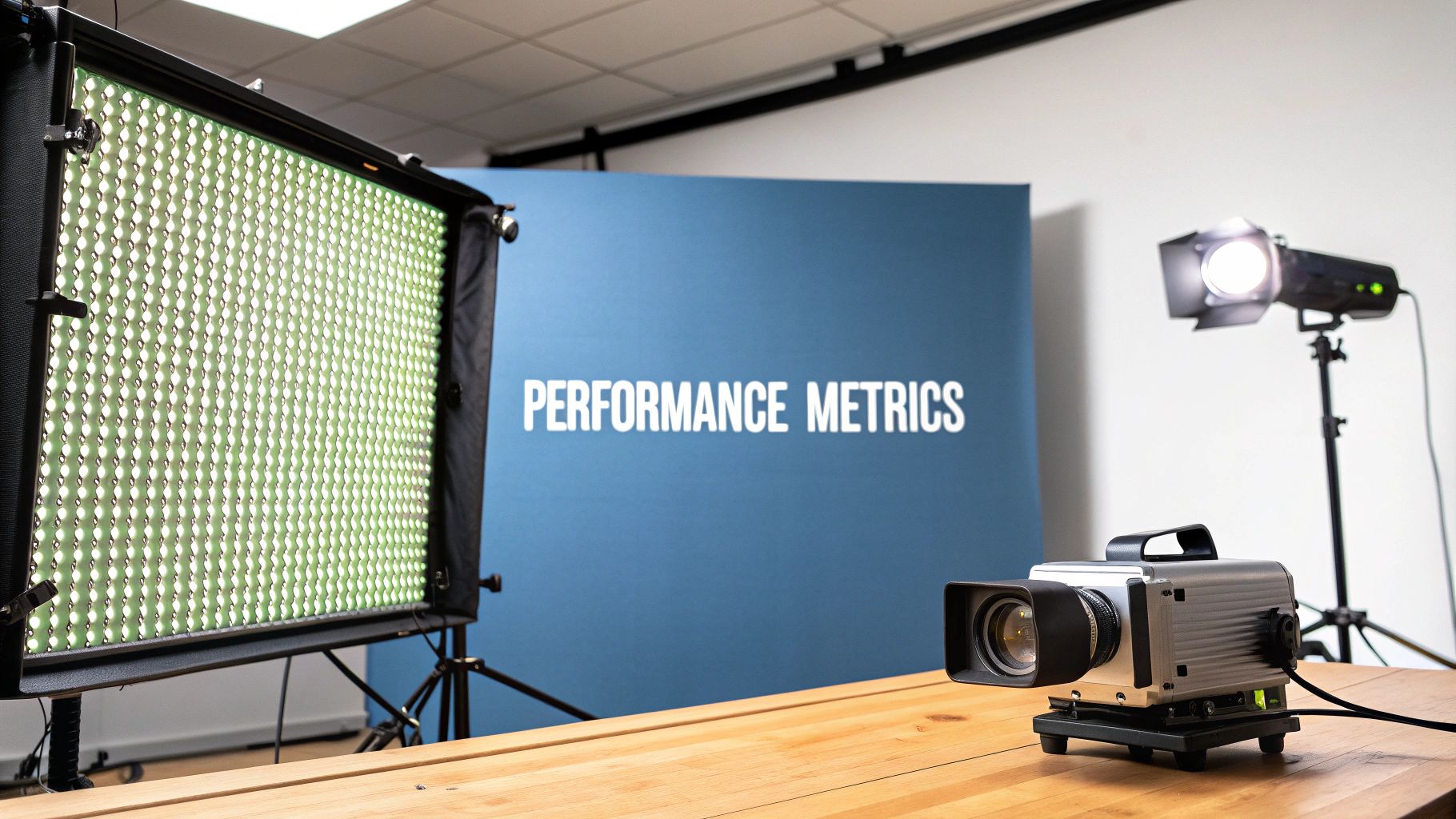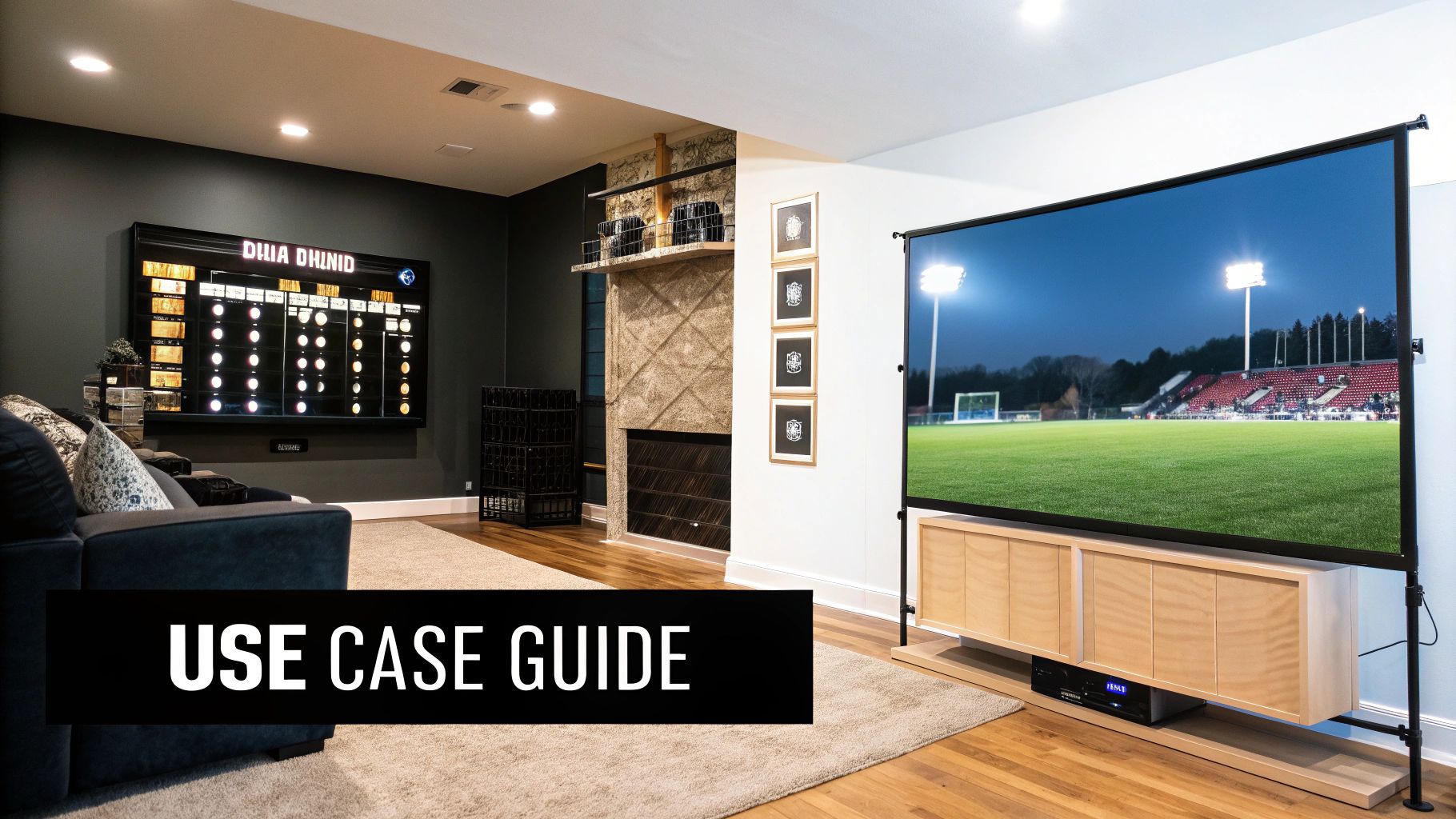
Choosing Scoreboards for Basketball A Complete Guide
A modern basketball scoreboard is so much more than a device for tracking numbers; it's the central nervous system of the entire game-day experience. It’s

At its core, the choice boils down to a single, fundamental difference: LED walls are self-emissive displays, while projectors are reflective. Think of it this way: an LED wall creates its own light, while a projector bounces light off another surface. This single distinction dictates where each technology shines—literally.
Your decision hinges on whether you need uncompromising visual impact and performance, or if budget and portability are your top priorities.

Choosing between an LED wall and a projector isn’t about picking a "winner." It's about matching the right tool to the right job. An LED wall is essentially a giant, incredibly bright television screen, built from modular panels that join together to form a single, seamless image. Because every single pixel generates its own light, it looks absolutely stunning, even in broad daylight.
A projector, on the other hand, works by casting an image onto a separate screen or wall. This classic approach is fantastic in controlled environments like a dark home theater or a dimly lit conference room. But the moment you introduce ambient light, the image starts to look washed out and faded.
For any mission-critical application where image clarity and brightness are non-negotiable—think retail stores, live events, or control rooms—an LED wall is the clear front-runner. For temporary setups or light-controlled rooms, a projector often provides a much more accessible entry point.
The market is already signaling a huge shift toward high-impact visuals. The global LED video wall market is expected to grow at a Compound Annual Growth Rate (CAGR) of about 11.15% from 2025 to 2032, rocketing to an estimated value of USD 58.90 billion. This boom is being fueled by industries like retail, advertising, and live events, where grabbing and holding an audience's attention is everything.
Sometimes you just need a quick, at-a-glance comparison. This table breaks down the core differences to help you see which technology aligns with your needs right away.
| Factor | LED Wall | Projector |
|---|---|---|
| Best Environment | Brightly lit spaces, even outdoors | Dark or dimly lit rooms |
| Brightness | Extremely high (emissive light) | Moderate (reflective light) |
| Initial Cost | Higher upfront investment | Lower initial investment |
| Lifespan | Extremely long (80,000-100,000 hours) | Shorter (requires lamp replacements) |
| Installation | More complex, requires mounting structure | Simpler, but requires throw distance |
Getting a handle on these key differentiators will help you start exploring more specific options, like the incredibly versatile indoor LED wall panels that are becoming more accessible for a wider range of projects.

To really settle the LED wall vs projector debate, we need to get past the surface-level stuff and dig into the specs that actually matter. A display's real-world performance boils down to a handful of critical metrics. Get these right, and you'll have a solution that doesn't just look good on paper but delivers a killer experience in your specific space.
This is where we get technical. We're going to break down five core performance areas to give you a solid foundation for your decision. It all comes down to how each display is built—one creates its own light, the other reflects it—and that fundamental difference changes everything.
The first thing you’ll notice when you put an LED wall next to a projector is the raw power of its brightness. An LED wall is an emissive display, meaning every single pixel is its own tiny light bulb. This allows it to pump out incredible levels of brightness, often measured in thousands of nits, making it strong enough to cut through direct sunlight.
Projectors are the opposite. They're reflective displays that work by shooting light onto a screen. Their brightness is measured in lumens—the total light output of the projector itself. Even the beefiest modern laser projectors lose some of that power when the light hits the screen and has to fight against any other light in the room.
This directly impacts contrast—the difference between the brightest white and the deepest black. Since LED pixels can shut off completely, they create a true, absolute black. The result is a nearly infinite contrast ratio that makes images pop with incredible depth and vibrancy.
A projector can never hit a true black. It’s always battling ambient light and even its own internal light leakage. In a perfectly dark room, the "black" you see is just an unlit spot on a white or gray screen, which will never be as deep as an LED pixel that's completely turned off.
Vibrant, true-to-life color is what makes visuals compelling, and this is another area where the tech really diverges. High-end LED walls are champs at reproducing a massive color gamut, often covering huge portions of the Rec. 2020 and DCI-P3 color spaces used in professional cinema. Because the light is direct, the colors are deeply saturated and stay consistent across the entire screen.
A projector's color performance is a bit more fragile. It depends heavily on the light source (lamp, laser, or LED) and the projection tech (DLP, LCD). While a perfectly calibrated, high-end projector can look amazing, its color can be easily thrown off.
Several things can mess with a projector’s color:
Resolution is simply the number of pixels on the screen (think 4K, which is 3840 x 2160 pixels). Both technologies can hit high resolutions like 4K and 8K, but how you experience that resolution is totally different.
With LED walls, the magic number is pixel pitch—the distance in millimeters from the center of one pixel to the center of the next. A smaller pixel pitch packs the pixels tighter, creating a higher pixel density. This gives you a seamless, super-detailed image you can stand right next to. A 1.2mm pitch wall will look way sharper up close than a 4mm pitch wall of the same physical size.
For projectors, the resolution is fixed by the chip inside. A native 4K projector outputs a 4K image, period. But the perceived sharpness, or pixel density, changes with the image size. If you project that 4K image onto a 100-inch screen, it will look much crisper than if you stretch it out to cover a 300-inch screen.
This is often the deciding factor. The emissive nature of an LED wall gives it a massive upper hand in any room that isn't a pitch-black cave. Pumping out thousands of nits, it can maintain a punchy, high-contrast, and color-rich image in a bright retail store, a sunlit corporate lobby, or an outdoor stadium.
Projectors just can't compete here. Any ambient light in the room is at war with the light coming from the projector. It washes out the image, crushes blacks, and sucks the life out of colors. You can get an Ambient Light Rejecting (ALR) screen to help, but they are a patch, not a fix, and often introduce problems like limited viewing angles.
The market data confirms this. LED displays dominate the market, with outdoor applications making up around 55% of their usage. Use cases like digital billboards, stadium screens, and traffic signs are places a projector simply can't go. You can read more about these LED market research findings.
Looking at the long game, LED walls are built to last. A typical LED panel is rated for 80,000 to 100,000 hours of use before its brightness drops by half. Plus, they’re modular. If one module or even a single pixel dies, you can often just swap it out without tearing down the whole wall.
Projectors, especially lamp-based ones, have a much shorter fuse. A standard lamp might only give you 2,000 to 5,000 hours of runtime before it needs replacing. Newer laser light sources are much better, lasting 20,000+ hours, but the projector itself is a single point of failure. If a key part like the imaging chip goes down, the entire unit is out of commission.
To put it all into perspective, let's look at the numbers side-by-side. This table cuts through the marketing fluff and gives you the hard data on how these two technologies stack up.
| Specification | Typical LED Wall | Typical High-End Projector | Key Takeaway |
|---|---|---|---|
| Brightness | 500 – 8,000+ nits | 3,000 – 30,000+ lumens | LED nits are measured at the screen, making them unbeatable in ambient light. Lumens degrade over distance. |
| Contrast Ratio | Effectively infinite (pixels turn off completely) | 1,000:1 to 2,000,000:1 (native/dynamic) | LEDs deliver true blacks for superior depth. Projector blacks are limited by ambient light. |
| Color Gamut | Up to 98% of Rec. 2020 / DCI-P3 | Up to 95% of DCI-P3 (laser models) | Both can be excellent, but LED color is more stable and less affected by the environment. |
| Resolution | Scalable (determined by pixel pitch and total size) | Fixed (e.g., 1080p, 4K, 8K) | LEDs offer total design freedom. Projector resolution is fixed, but pixel density changes with image size. |
| Lifespan | 80,000 – 100,000 hours (to half-brightness) | 2,000 – 5,000 hours (lamp), 20,000+ hours (laser) | LEDs offer a significantly longer operational life and superior long-term reliability. |
| Ambient Light Perf. | Excellent; viewable in direct sunlight | Poor to fair; requires light control for best results | This is the knockout punch. LEDs thrive where projectors struggle or fail completely. |
This direct comparison makes the core differences crystal clear. While a high-end projector is a powerful tool in the right setting (a dark, controlled room), an LED wall's fundamental technology gives it a raw performance advantage in brightness, contrast, and longevity that's tough to beat in most professional applications.
When you're weighing an LED wall against a projector, the initial price tag is just the start of the story. Anyone who's been in the AV game for a while knows that the real financial picture comes from the Total Cost of Ownership (TCO). It's a simple framework, but it's crucial—it accounts for every single expense over the display's entire working life.
A projector might look like the easy, budget-friendly win at first glance. But a closer look at the hidden costs that pop up down the road can close that initial price gap faster than you'd think. To make a smart investment, you have to break it down into three phases: the upfront purchase, the installation, and the long-term operational costs. It’s this complete picture that often reveals a surprising truth: the cheapest option on day one is rarely the cheapest in the long run.
Let's start with the most obvious difference: the initial capital outlay. Projectors, especially for smaller setups, have a much lower barrier to entry. You can get your hands on a very capable 4K laser projector for a fraction of what an LED wall of the same size would cost.
An LED wall's price is a different beast altogether, driven primarily by its pixel pitch and sheer size. A tighter pixel pitch—which is absolutely essential if people will be viewing it up close—means more LED clusters packed together, and that drives up the manufacturing cost significantly. The price isn’t just for the panels either; you're also paying for sending cards, video processors, and a seriously robust mounting structure to handle all that weight. A projector's shopping list is much simpler: the unit, a screen, and a mount.
The initial cost of a high-resolution LED wall can be 3 to 10 times higher than a comparable high-end commercial projector and screen setup. This makes projectors a really attractive choice for anyone working with a tight initial budget.
Beyond the hardware itself, installation brings a whole new set of costs to the table. Putting in a projector is pretty straightforward. It’s often a job for a small team or even a single skilled tech—mount the projector, hang the screen, run some cables. It's usually quick and not too labor-intensive.
LED walls? That’s a whole different level of involvement. The installation is a specialized, multi-step process that demands real expertise.
These factors make installing an LED wall a much bigger line item on the budget, adding a hefty sum to that initial investment.
Here’s where the financial script often flips. Over a five- or ten-year lifespan, the ongoing expenses of running a projector can start to catch up to, and even surpass, the high upfront cost of an LED wall.
The biggest recurring headache with projectors is component replacement. The old lamp-based models need new bulbs every 2,000 to 5,000 hours, which creates a predictable cycle of maintenance costs and downtime. Even modern laser projectors, which boast a 20,000+ hour lifespan, will eventually need their light source replaced. That’s not a simple swap; it's an expensive and highly technical procedure.
In sharp contrast, LED walls are built for the long haul, with lifespans rated for 80,000 to 100,000 hours of operation. Their modular design is their secret weapon from a financial standpoint. If a single panel or even a tiny module fails, you can pop it out and swap in a new one quickly and cheaply, without taking the whole display offline.
Energy consumption is another big piece of the puzzle. Yes, a large, bright LED wall draws a lot of power, often more than a single projector. But you have to consider the environment. A projector needs a dark, climate-controlled room to perform at its best, which means you're spending more on HVAC and specialized lighting control. When you factor that in, the energy costs can start to even out. For a deeper dive into the factors that influence display costs, particularly for outdoor use, you can learn more about the outdoor LED sign cost on our blog.
Ultimately, for most commercial applications, the dramatically lower maintenance and longer lifespan of an LED wall often lead to a lower TCO, justifying its higher upfront price tag over the life of the investment.

Technical specs are one thing, but the real test in the LED wall vs projector debate happens out in the field. The best display isn't the one with the most impressive numbers on paper; it's the one that gets the job done perfectly in its intended environment.
From sun-blasted retail storefronts to pitch-black home cinemas, the demands on a display shift dramatically. Let's move from theory to application and break down five common scenarios to see where each technology truly shines.
The modern corporate space is all about clarity, collaboration, and making a killer first impression. Presentations today are a mix of intricate data, crisp video calls, and dynamic media. The big challenge is versatility—the screen has to look amazing whether the lights are dimmed for a video or fully on for an interactive workshop.
This is where an LED wall is the undisputed winner. It maintains stunning brightness and contrast regardless of ambient light, so you never have to kill the lights just to see the screen. With a fine pixel pitch (usually 1.2mm to 2.5mm), even detailed financial charts and tiny text are razor-sharp for everyone, from the front row to the back of the room.
In a boardroom, a washed-out projector image can sink the whole presentation. It signals a lack of investment and professionalism. An LED wall’s vibrant, consistent image projects authority and guarantees every detail lands with maximum impact.
In the world of retail and Digital Out-of-Home (DOOH) advertising, attention is everything. These displays aren't just showing content; they're battling direct sunlight, streetlights, and a sea of other visual noise. The goal is to deliver a message so bright and compelling that it’s impossible to ignore.
This is a fight projectors can't even enter. The raw brightness needed to be seen in broad daylight is miles beyond what any projector can deliver. An outdoor-rated LED wall, with brightness levels that often blast past 7,000 nits, is the only tool for the job. It pumps out rich, saturated colors and fluid video that stays brilliant even on the sunniest days.
Plus, the modular nature of LED panels lets you get creative. You can wrap them around corners, build massive seamless backdrops, or fit them into weird architectural spaces, turning a basic storefront or billboard into a genuine landmark.
Concerts, festivals, and massive corporate events need displays that are not only huge but also bright enough for thousands of people to see clearly from hundreds of feet away. The screen is often the centerpiece of the whole show, used for IMAG (image magnification), sponsor loops, and mind-bending visual backdrops.
Here again, the LED wall is the industry standard. Its scalability lets production crews build video screens of almost any size or shape, creating truly immersive stage designs. That superior brightness ensures the fans in the cheap seats can see the action on stage, even in an open-air stadium during the day.
While projectors might pop up in smaller, controlled breakout sessions, they just don't have the muscle or flexibility for the main stage. The logistics of rigging giant projectors and dealing with shadows and sightlines make them a non-starter for most large-scale live productions.
For the true cinephile, the home theater is a sanctuary. It’s a space built for one thing: the ultimate cinematic experience. Here, the rules flip. The room is completely light-controlled, ambient brightness is basically zero, and the goal is to reproduce the filmmaker's vision with absolute color accuracy and detail.
In this specific niche, a high-quality 4K or 8K projector is often still king. Projectors are masters at creating a soft, film-like image that many movie lovers find more natural and easier on the eyes for a three-hour epic. Because the light is reflective, it avoids that "giant TV" glow some people get from emissive displays, keeping the classic movie-watching vibe alive.
The global DLP projector market, valued around USD 6.23 billion in 2025, isn't exploding like LED technology, but it maintains a powerful grip on the home cinema world. Its cost-effectiveness at huge screen sizes and mature imaging technology give it lasting appeal, especially as demand for home entertainment rises. You can learn more about the projector market's steady growth and trends to see why it remains a strong contender.
Mission-critical environments like security operations centers (SOCs) and network operations centers (NOCs) play by a different set of rules. Operators are monitoring dozens of high-res data and video feeds 24/7. The display has to be insanely reliable, show impeccable detail, and be comfortable to stare at for long shifts.
An LED wall is the hands-down superior solution for a modern control room. Here’s why:
Years ago, multi-projector setups with edge blending were the norm, but they were a nightmare to maintain. They suffered from color and brightness shifts over time and needed constant recalibration. The arrival of affordable, fine-pitch LED technology has made it the new gold standard for any environment where data and reliability are everything.
Beyond the spec sheets and eye-popping visuals, the real-world logistics of installation and long-term care are where the LED wall vs projector debate gets serious. These factors hit your budget, your timeline, and your need for specialized help, so it's critical to know what you’re really signing up for.
At first glance, a projector setup seems straightforward. You mount the unit, hang a screen, and run a few cables. But that simplicity is deceptive. Getting the throw distance just right—the exact space between the lens and screen—is the first hurdle, and it dictates where everything else can go.
Get that calculation wrong, and you're in for a world of frustration. Achieving a perfectly square image means painstakingly aligning everything and often leaning on digital tricks like keystone correction, which can subtly soften the picture you worked so hard to get.
Installing an LED wall, on the other hand, feels less like an A/V job and more like a small construction project. The sheer weight of hundreds of panels is no joke. You'll almost certainly need an engineer to sign off on the wall's load-bearing capacity, and a custom-built frame is pretty much standard procedure.
This is definitely not a one-person task. It takes a trained crew to painstakingly piece together each cabinet, ensuring every seam is invisible and every panel is perfectly aligned. It’s a game of millimeters where the goal is a flawless, monolithic image.
Once it's built, the real technical work begins:
This is where the two technologies go in completely different directions, creating distinct cycles of cost, labor, and potential downtime. Projectors are all about predictable, repeating maintenance. If you have a lamp-based model, you're swapping bulbs every 2,000 to 5,000 hours. All projectors need their filters cleaned regularly to keep from cooking themselves.
Even with modern laser projectors that push the light source life past 20,000 hours, the unit is still a single point of failure. If a core component like the imaging chip dies, the whole screen goes dark until a technician can fix or replace it.
With an LED wall, you're not just replacing a single part on a schedule. You're managing a modular ecosystem. The entire mindset shifts from reactive replacement to proactive monitoring and quick, targeted repairs.
The modularity of an LED wall is its superpower for maintenance. The panels themselves are workhorses, rated for 80,000 to 100,000 hours of continuous operation. If a single module—or even just one pixel—goes out, a technician can often pop it out and swap in a new one in minutes. The rest of the display never has to go down. This resilience is precisely why LED walls are the go-to choice for mission-critical command centers and broadcast studios where downtime is simply not an option.
Alright, you've made it to the final round. When it comes to the led wall vs projector showdown, the right choice really boils down to your specific circumstances. Let's walk through a few key questions to zero in on the perfect display for your space.
Think of this as your final sanity check. Answering these questions honestly will make the decision feel less like a technical puzzle and more like a natural fit.
This decision tree gives you a quick visual guide based on how complex your installation will be.

What this really drives home is that an LED wall isn't just a screen; it's a piece of high-performance infrastructure. The installation is more involved because it's built to be a permanent, powerhouse fixture.
Final Recommendation: For any kind of high-stakes public advertising or mission-critical operations room, your best bet is an LED wall with a pixel pitch under 3mm and a brightness that exceeds 5,000 nits. If you’re building a home cinema or outfitting a classroom on a tighter budget with full light control, a quality 4K laser projector is a fantastic investment.
If you’re still mapping out the procurement side of things, our complete guide on how to buy an LED sign breaks down every step in detail.
Even after weighing the pros and cons, a few lingering questions often pop up when you're on the brink of a decision. We get it. Here are the straight-up answers to the most common queries we hear, designed to help you lock in your choice with total confidence.
In a word, no. While a top-tier commercial projector can pack a serious punch, it’s still no match for the raw, emissive power of an LED wall, especially when you’re dealing with ambient light.
An LED wall's brightness is measured in nits, and it’s not uncommon for outdoor models to blaze past 7,000 nits—bright enough to look incredible in direct sunlight. A projector’s brightness, measured in lumens, is always in a battle with the room’s lighting. It works by bouncing light off a surface, but an LED wall is the light source. That gives it an unbeatable edge in delivering visuals that pop.
Yes, and it’s important to be realistic about this. Installing an LED wall is a full-blown construction project, not a simple setup. It involves meticulously aligning individual panels, building structural support to handle a lot of weight, and having specialized expertise to wire and configure everything.
A projector install is certainly more straightforward—you’re typically just mounting the unit and a screen. But don't underestimate the challenges. Nailing the throw distance and correcting for keystone distortion to get a perfectly square image is a science in itself.
The real difference comes down to scale and precision. A projector setup is a task you can plan and execute. An LED wall installation is a structured project that absolutely requires a professional team to get a flawless, lasting result.
Pixel pitch is simply the distance, in millimeters, from the center of one pixel to the center of the next. The smaller the number, the closer the pixels are packed together. This creates a much higher resolution and a seamless, smooth image.
Why does it matter so much? It all comes down to viewing distance.
Ready to transform your space with a brilliant, high-impact display? At Smart LED Inc., we provide factory-direct indoor and outdoor LED solutions tailored to your specific needs. Explore our custom LED walls and signs today and see the difference for yourself.

A modern basketball scoreboard is so much more than a device for tracking numbers; it's the central nervous system of the entire game-day experience. It’s

Sure, the digital world gets all the hype, but when it comes to forging real connections and landing qualified leads, nothing beats a killer trade

A digital message board is more than just a screen; it's a living, breathing poster. Instead of static ink on paper, it uses brilliant screen
"*" indicates required fields